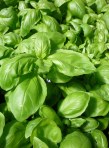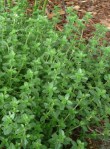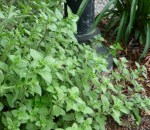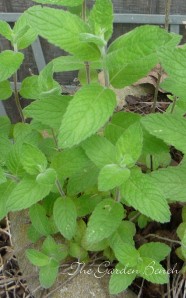I’m planning to grow an herb garden for the first time. When is the best time to set out transplants?
Now that spring is definitely on the way, of course we’re anxious to get things planted, and the herb garden is a good place to start. Some herbs can withstand chilly temperatures, and may already be available at nurseries or garden centers. Herbs that are more hardy – sage, thyme, oregano, parsley, cilantro, rosemary – can be set out very early, but to be safe (and depending on the climate in your area) you may want to wait until closer to the last frost date. (That’s around mid-April in USDA Hardiness Zone 7a, where The Garden Bench calls home).
Tender herbs such as basil absolutely will not tolerate cold weather, and you should
wait until after the last frost date – or even a few days longer, just in case — to set out transplants.
In general, herbs grow best in well-drained soil in a spot that gets full sun, but there are a few herbs that do well in partial sun or partial shade. Garden author Judy Lowe lists chives, cilantro, lavender, lemon balm, parsley and sweet bay as plants that tolerate a little shade.
And for aspiring gardeners without a place to dig, herbs do well in containers — alone or planted with other herbs in a garden arrangement. At the appropriate time, set transplants in containers in good potting soil. Place them in a sunny spot on the deck, porch or patio, and keep the containers well-watered.
Color all year long – And a book giveaway!
Nellie Neal’s appreciation for color in the landscape began while she was college.
“I became aware of this garden that was on my route every day. I noticed that it didn’t matter what day of the year it was, there was something going on that was worth a look.” She watched throughout the cycle of the year: where the azaleas bloomed, where the gardenias flowered. In winter, where the shrubs held gorgeous berries.
“It’s really when I became enamored with how the colors and the form go together to create this effect.”
Today, Nellie is a garden writer and radio host living in Jackson, Miss. and the author  of The Nonstop Color Garden, a guide to designing flowering landscapes for year-round enjoyment.
of The Nonstop Color Garden, a guide to designing flowering landscapes for year-round enjoyment.
Nellie offers some of her garden color tips in a story in today’s Style section in The Tennessean. Here at The Garden Bench, I’m giving away a copy of the book.
Leave a comment at the end of this post about your favorite season for color — or just name a color you like. Respond by 6 p.m. Friday, March 20, 2015 and your name will go into a drawing to win a copy of Nellie Neal’s The Nonstop Color Garden.
Filed under: Book Giveaway, Herbs | Tagged: basil, chives, cilantro, cool weather, dill, flowers, garden books, Garden color, giveaway, herbs, parsley, Rosemary, sage, thyme, USDA Hardiness Zone Map | 6 Comments »















